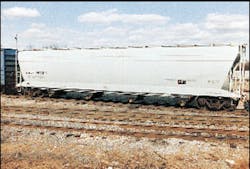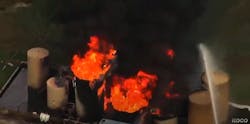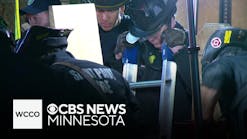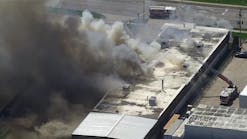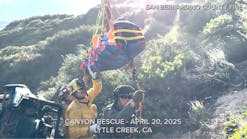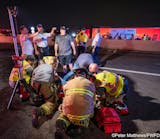Types of hazardous materials carried by rail are much like those transported on highways, but again a primary difference is the increased amount of product being transported in individual containers. Additionally, there may be more than one tank car of the same product, or multiple products.
Highway emergencies usually involve single amounts or small amounts of several chemicals, but rail incidents can involve from one to 100 or more tanks of the same or varying types of hazardous materials. Increased amounts of hazardous materials only compound the situation, making the work of response personnel difficult.
Railroad tank cars contain bulk quantities of hazardous materials and are the primary concern of emergency responders in derailments or other types of rail accidents. In fact, over 80% of all hazardous materials are transported by rail and tank cars account for 70% of the total. Most serious railroad hazmat incidents involve tank cars; therefore, they will be the focus of most of this column.
Cargoes Vary Greatly
More than 200,000 tank cars are used in rail transportation in the U.S. Most tank cars are not owned by railroads, but by private companies. Over 1,200 are owned by the U.S. government and supervised by the military. Government cars are used to transport jet fuels, nitrogen-tetroxide (a rocket fuel) and materials used in weapons production. The amounts of a hazardous material in a tank car can range from a few hundred gallons to as much as 34,500 gallons. (No tank car is considered empty unless it has been purged of the product and cleaned.)
Railroad tank cars are assigned identification numbers that identify the type of tank – pressure, non-pressure, cryogenic or miscellaneous. Tank cars transporting hazardous materials can be identified through 100-series numbers regulated by the U.S. Department of Transportation (DOT). Tank cars that carry non-hazardous commodities such as corn syrup and cooking oil bear 200-series numbers and are regulated by the Association of American Railroads (AAR), are not considered hazardous materials containers.
Numerical designations for tank car designs are as follows:
- Pressure Tank Car Designations – DOT 105, 109, 112, 114 and 120.
- Non-Pressure Tank Car Designations – DOT 103, 104, 111 and 115; and AAR 201, 203, 206 and 211.
- Cryogenic Tank Car Designations – DOT 113; AAR 204 and 204XT.
- Miscellaneous Tank Car Designations – DOT 106, 107 and 110; and AAR 207 and 208.
While the numbering system for railroad cars identifies particular types of tanks, the numbers may not be readily visible to emergency responders from a safe distance.
The most important concern for emergency responders about a tank car is whether it is a pressure or non-pressure tank. Pressure tanks present a much more difficult and dangerous situation for response personnel than non-pressure cars.
Pressure tank cars and non-pressure tank cars can be differentiated by looking at the locations of valves and other piping on the tops of the cars. On a pressure car all valves and piping are enclosed within a dome at the top center of the tank car. The dome is designed to prevent damage during a derailment. Non-pressure cars can have unprotected valves and piping on tops of the tanks or, in some cases, on top of the domes. Non-pressure tanks may also have bottom fittings and washouts.
Pressure tanks are top loaded through the dome assembly and generally are used to transport flammable and non-flammable gases and poison gases. The tanks may be insulated or non-insulated, and are hydrostatically tested for pressures of 100 to 600 psi. Pressure tank cars present a much more significant hazard to response personnel than do non-pressure cars under heat or flame impingement conditions.
Non-pressure tank cars are hydrostatically tested from 35 to 100 psi. They commonly are used to transport flammable and combustible liquids, flammable solids, oxidizers, organic peroxides, poison liquids, and corrosives. (There are exceptions; for example, DOT 111 tank cars may carry specific flammable and non-flammable gases.)
Tank cars are constructed from a variety of materials, including carbon steel, aluminum, stainless steel, nickel, chromium and iron. Single thicknesses of tank materials range from one-eighth to three-quarters of an inch. Tank car design standards are found in 49 CFR, Part 179 of the DOT Hazardous Materials Regulations. Modifications may occur to tanks that accommodate products transported because of product temperature, flammability or chemical reactivity. Tanks may be insulated externally to protect against the effects of ambient temperatures. Insulation materials can include fiberglass, polyurethane or pearlite; cork is used in some older tank cars.
Tanks may also be provided with thermal protection designed to keep tank temperatures below 800 degrees Fahrenheit during a 100-minute pool-fire or 30-minute torch-impingement test. This protection is provided by a layer of wool or ceramic fiber covered by a one-eighth-inch steel jacket. Thermal protection can also be provided through a textured coating sprayed onto a tank’s outer surface. Heat from a flame exposure is absorbed by the coating material and is not transferred to the tank metal. Metal does not hold up well to direct flame contact and will fail in 15 to 20 minutes, according to information from the National Fire Protection Association (NFPA).
Tank cars are protected from physical damage during an accident by shelf couplers and head shields. Shelf couplers are designed to stay together so they do not puncture another car during a derailment or other accident. Head shields provide an extra layer of metal to help prevent dents and punctures when a pressure tank is hit by another car or object.
Cryogenic Tanks
Cryogenic railroad tank cars are usually constructed of nickel or stainless steel as a tank within a tank. Cryogenic tanks may also be found within boxcars. Because cryogenic liquids are very cold, insulation is placed between the two tanks and a vacuum pulled on the space to maintain the temperature. This process will allow the tank car a 30-day holding time.
Cryogenic cars transport various gases, including flammable hydrogen, liquid oxygen and poisons. Some cryogenic gases, such as nitrogen and argon, are considered inert. Temperatures of these liquefied gases can range from the warmest, carbon dioxide at –130F, to the coldest, helium at –452F. Thermal hazards of these materials are significant.
In addition to thermal hazards, cryogenic liquids have a large liquid-to-vapor expansion ratio. A small leak from a valve or container can create a large vapor cloud. Some ratios are as great as 900 to 1, meaning one gallon of cryogenic liquid can produce over 900 gallons of gas.
Multi-unit rail cars are used to transport individual tanks of gases in uninsulated “ton containers.” They are removed from the car for use, refilled and re-transported. Products carried include chlorine, phosgene, anhydrous ammonia and refrigerants. “Ton containers” have a 180- to 320-gallon water capacity and are pressure tested from 500 to 1,000 psi. They may be transported by rail or truck and can be found on special flat cars, boxcars or gondola cars, as well as on “trailer on flat car” (TOFC), or “container on flat car” (COFC) units.
High-pressure tank cars (similar to highway tube trailers) are approximately 40 feet long and contain a series of 25 to 30 steel cylinders or individual tanks that are tested to 4,000 psi. High-pressure tanks are not insulated and are equipped with pressure relief valves, and are usually used to transport helium or hydrogen.
Another type of pressure tank car is only pressurized during unloading. This car is a pneumatically unloaded, covered hopper car. Pressure is applied during the unloading process and the tank is tested to between 20 and 80 psi. This type of tank is used for dry caustic soda.
Warnings Posted
Railroad tank cars, as previously mentioned, are built to DOT specifications for hazardous materials transportation. Certain markings are required to be stenciled on each tank car as a part of the specification requirements.
Of particular interest to emergency responders is the requirement that names of certain commodities be stenciled on both sides of the tank car in four-inch-high letters. Some 50 materials require name stenciling; these include anhydrous ammonia, chlorine and liquefied petroleum gas. Additionally, if a material is an “Inhalation Hazard,” that too must be stenciled on the container above the commodity name.
A tank containing hazardous materials will bear a DOT specification including DOT followed by the tank car type, such as 111, or DOT-111. Next to the tank car type will be a letter designating the type of protection the pressure car has for accidents or flame exposure:
- A – the tank has top and bottom shelf couplers.
- S – the tank has A plus head puncture resistance.
- J - the tank has A and S and jacket thermal protection.
- T - the tank has A, S, J and spray-on thermal protection.
If the tank is a pressure container, following the letters will be a number indicating the tank test pressure. Following the test pressure will be letters designating the type of material in which the tank is constructed: Al designates aluminum, N nickel, and C, D and E for stainless steel. Non-pressure tanks will not have the test pressure information.
Unless they are carrying certain poison gases, such as hydrocyanic acid, pressure tanks have relief valves designed to relieve excess pressure caused by increases in ambient temperature. These relief valves are not designed to relieve the pressure created from radiant heat from a fire or other source or direct flame impingement.
Many accidents have occurred over the years from boiling liquid expanding vapor explosions (BLEVEs) when pressure containers have had excess pressure buildup. These accidents have resulted in many firefighter and civilian deaths and injuries when pressure relief valves could not keep up with internal pressure buildup and the tanks failed.
Boxcar Shipments
Boxcars are also used to transport hazardous materials. Individual container sizes inside boxcars are 119 gallons or less and, in many cases, 55 gallons or less. Potentially, any class of hazardous material may be included in boxcar shipments.
Flat cars are used to ship pallets of hazardous materials, including small containers. Flat cars are also used to carry “intermodal containers,” which can be box containers or any type of bulk tank container. Intermodal containers get their name from the fact that they are shipped by highway, rail and water. They can carry any class of hazardous material and the quantities will be smaller than ordinary highway or rail containers. There can, however, be multiple intermodal containers that can present a quantity problem during an accident.
Hopper cars do not always contain hazardous materials, but the physical state of the materials in the container may present a hazard. When suspended in air, fine powders and dusts can become a dust explosion hazard. An accident could cause the materials to be airborne; if an ignition source is present, a dust explosion can occur.
Response personnel who have railroads that transport hazardous materials through their jurisdictions should be familiar with types of rail cars and the hazardous materials they contain. NFPA 472, 1997 edition, lists the competencies that a hazmat technician with a railroad tank car specialty should have.
Robert Burke, a Firehouse® contributing editor, is the fire marshal for the University of Maryland. He is a certified Hazardous Materials Specialist, and has served on state and county hazmat response teams. Burke is a veteran of over 18 years in the fire service, in career and volunteer fire departments, having attained the ranks of lieutenant and assistant chief, and served as deputy state fire marshal. He has an associate’s degree in fire protection technology and a bachelor’s degree in fire science, and is pursuing a master’s degree in public administration. Burke is an adjunct instructor at the National Fire Academy. He is the author of the books Hazardous Materials Chemistry For Emergency Responders, published in 1997, and Counter-Terrorism For Emergency Responders, published in 1999. Burke can be reached on the Internet at [email protected].